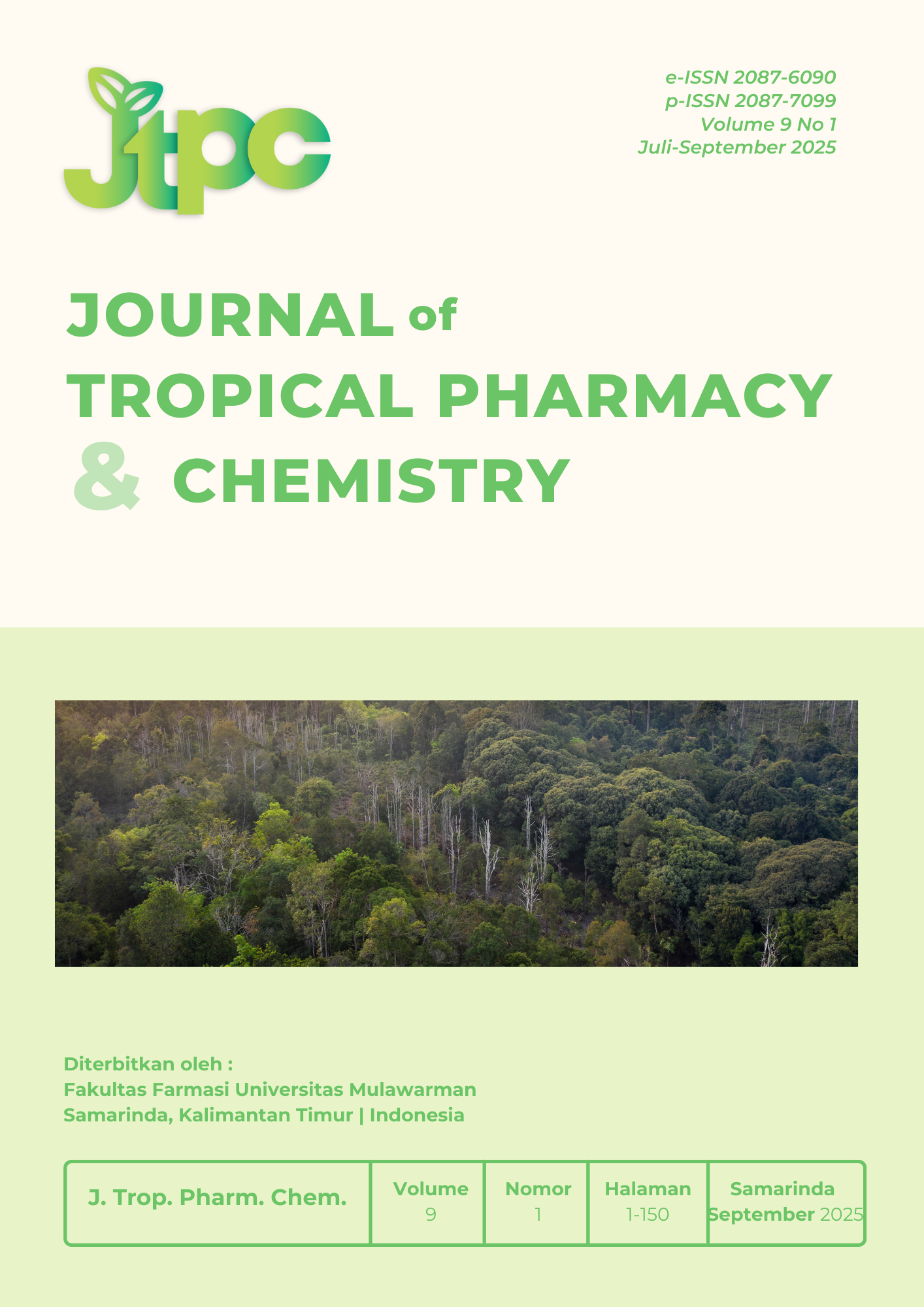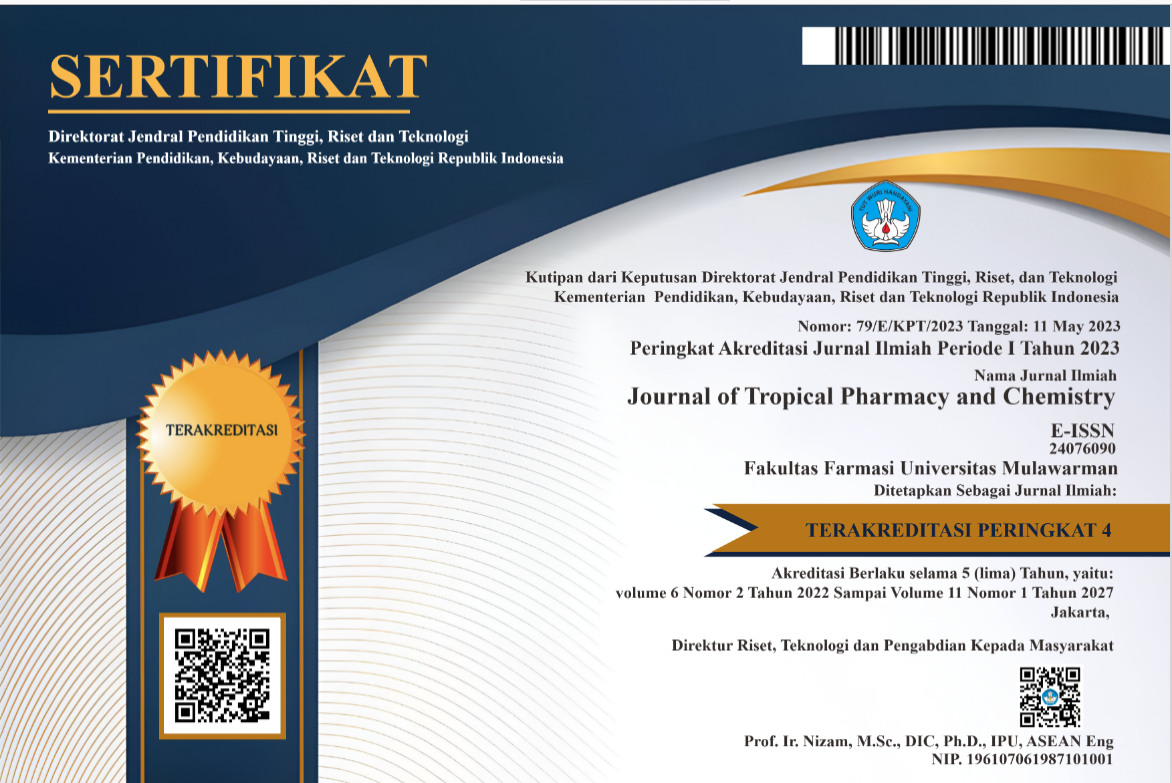Formulation and Characteristic Test of Handbody Lotion Preparation of Pucuk Merah Leaf Extract (Syzygium myrtifolium Walp.) as An Antioxidant
DOI:
https://doi.org/10.30872/jtpc.v9i1.287Abstract
Lotions made from natural ingredients are increasingly favored by the public, primarily due to the addition of active compounds that are functional for the skin, such as antioxidants. Antioxidants play an important role in maintaining health by improving skin texture. One potential source of natural antioxidants is the pucuk merah leaf (Syzygium myrtifolium Walp.), which is known to contain phenolic and flavonoid compounds. This study aimed to determine the physical characteristics and antioxidant activity of pucuk merah leaf extract lotion with varying extract concentrations: F1 (0.5%), F2 (2.5%), and F3 (12.5%). The results showed that all formulas met the standards for a good lotion based on organoleptic tests, homogeneity, pH, viscosity, adhesion, spreadability, and emulsion type. Formula 1 was identified as the best formulation based on its organoleptic properties, showing a better dosage form compared to the other formulas. The antioxidant activity was classified as very strong, with IC50 values for each formula being 49.609 ppm (F1), 47.202 ppm (F2), and 35.809 ppm (F3). The antioxidant activity of each formula increased with higher extract concentrations.
Downloads
References
[1] M. Kumar, U. K. Mandal, and S. Mahmood, “Dermatological formulations,” in Dosage Forms, Formulation Developments and Regulations, Elsevier, 2024, pp. 613–642.
[2] G. Kulkarni, A. Abraham, and M. Kulkarni, “Algae-Sourced Bioactives with Promising Applications in Skincare Cosmeceuticals,” pp. 37–45.
[3] H. S. K. M. Lourdes Mourelle, “No Title,” Thalassother. Cosmeceuticals, vol. 2, doi: https://doi.org/10.1201/9781003399285.
[4] S. Knox and N. M. O’Boyle, “Skin lipids in health and disease: A review,” Chem. Phys. Lipids, vol. 236, p. 105055, 2021, doi: https://doi.org/10.1016/j.chemphyslip.2021.105055.
[5] M. Boer, E. Duchnik, R. Maleszka, and M. Marchlewicz, “Structural and biophysical characteristics of human skin in maintaining proper epidermal barrier function,” Postep. Dermatologii i Alergol., vol. 33, no. 1, pp. 1–5, 2016, doi: 10.5114/pdia.2015.48037.
[6] C. Maxim, D. Turcov, A. G. Bulgariu, and D. Șuteu, “Squalene-Background and Perspectives in Cosmeceuticals Formulas,” vol. 70, no. 74, 2024, doi: 10.5281/zenodo.11145431.
[7] I. Sagrafena et al., “Structure and function of skin barrier lipids: Effects of hydration and natural moisturizers in vitro,” Biophys. J., pp. 1–13, 2024, doi: 10.1016/j.bpj.2024.10.006.
[8] M. A. Dias da Rocha et al., “Unveiling the Nuances of Adult Female Acne: A Comprehensive Exploration of Epidemiology, Treatment Modalities, Dermocosmetics, and the Menopausal Influence,” Int. J. Womens. Health, vol. 16, pp. 663–678, 2024, doi: 10.2147/IJWH.S431523.
[9] V. Fu and G. Lu, Skincare Decoded: The Practical Guide to Beautiful Skin. Simon and Schuster, 2021.
[10] K. Miner et al., “Lipid Dysregulation in Sebaceous Gland Disorders and the Impact of Sphingolipid Metabolism on Acne Pathogenesis,” Cureus, vol. 17, no. 4, 2025.
[11] M. Hingankar, J. Mendwade, R. Thakur, S. Mahajan, and P. R. Gahlod, “Skin Aura : The Impact of Moisturizers on Maintaining Skin Hydration,” vol. 8, no. 5, pp. 345–351, 2024.
[12] J. Zdrada, W. Odrzywołek, A. Stolecka-Warzecha, S. Wilczyński, and B. Błońska-Fajfrowska, “The influence of cosmetics dedicated to oily and acne-prone skin on skin parameters,” J. Cosmet. Dermatol., vol. 21, no. 11, pp. 6092–6099, 2022.
[13] A. K. Mohiuddin, “Acne Protection: Measures and Miseries,” Dermatology Clin. Res. DCR, vol. 5, no. 1, pp. 272–311, 2019.
[14] Y. B. Lee, E. J. Byun, and H. S. Kim, “Potential role of the microbiome in acne: A comprehensive review,” J. Clin. Med., vol. 8, no. 7, pp. 1–25, 2019, doi: 10.3390/jcm8070987.
[15] A. Palange, M. Barge, and N. Naikwadi, “Review in Acne Vulgaris along with its treatment,” Asian J. Pharm. Res. Dev., vol. 11, no. 3, pp. 192–196, 2024.
[16] A. Decker and E. M. Graber, “Over-the-counter acne treatments: a review,” J. Clin. Aesthet. Dermatol., vol. 5, no. 5, p. 32, 2012.
[17] H. Ojaniemi, “Developing Consumer Claims in Cosmetic Industry,” no. June, 2024.
[18] L. Talakoub, I. M. Neuhaus, and S. S. Yu, “Antiaging cosmeceuticals,” in International Textbook of Aesthetic Surgery, Springer, 2016, pp. 1183–1209.
[19] N. Nuhii et al., “ADOLESCENTS KNOWLEDGE ON THE USE OF COSMETIC AND DERMATOLOGICAL PREPARATIONS IN THE TREATMENT OF ACNE VULGARIS,” ACTA MEDICA Balk. Int. J. Med. Sci., vol. 9, no. 17–18, pp. 205–214, 2024.
[20] A. A. Almeman, “Evaluating the Efficacy and Safety of Alpha-Hydroxy Acids in Dermatological Practice: A Comprehensive Clinical and Legal Review,” Clin. Cosmet. Investig. Dermatology , vol. 17, pp. 1661–1685, 2024, doi: 10.2147/CCID.S453243.
[21] C. Zhang et al., “Expert consensus on perioperative integrated skincare for noninvasive energy-based device aesthetic procedures in clinical practice in China,” J. Eur. Acad. Dermatology Venereol., 2024.
[22] N. Sampattavanich, N. Chandayani, J. Intarasupht, and A. Nakakes, “An in vivo study to evaluate the influence of oil blotting paper on the efficacy of sunscreen,” Photodermatol. Photoimmunol. & Photomed., vol. 37, no. 4, pp. 324–328, 2021.
[23] E. Woolhiser, N. Keime, A. Patel, I. Weber, M. Adelman, and R. P. Dellavalle, “Nutrition, Obesity, and Seborrheic Dermatitis: Systematic Review,” JMIR dermatology, vol. 7, p. e50143, 2024.
[24] S. M. Mawazi et al., “A review of moisturizers; history, preparation, characterization and applications,” Cosmetics, vol. 9, no. 3, p. 61, 2022.
[25] M. Maarouf, C. L. Maarouf, G. Yosipovitch, and V. Y. Shi, “The impact of stress on epidermal barrier function: an evidence-based review,” Br. J. Dermatol., vol. 181, no. 6, pp. 1129–1137, 2019.
[26] M. Chwil, R. Matraszek-Gawron, P. Terlecka, M. Skoczylas, K. Terlecki, and others, “Comprehensive Review of the Latest Investigations of the Health-Enhancing Effects of Selected Properties of Arthrospira and Spirulina Microalgae on Skin,” Pharmaceuticals, vol. 17, no. 10, p. 1321, 2024.
[27] A. Choopani, M. Poorsoltan, M. Fazilati, A. M. Latifi, and H. Salavati, “Spirulina: a source of gamma-linoleic acid and its applications,” J. Appl. Biotechnol. Reports, vol. 3, no. 4, pp. 483–488, 2016.
[28] A. Durairaj, K. Elumalai, and A. Shanmugam, “Cystic acne treatment: A comprehensive review,” Med. Adv., vol. 1, no. 4, pp. 318–329, 2023.
[29] O. A. Al Hanbali, H. M. S. Khan, M. Sarfraz, M. Arafat, S. Ijaz, and A. Hameed, “Transdermal patches: Design and current approaches to painless drug delivery,” Acta Pharm., vol. 69, no. 2, pp. 197–215, 2019.
[30] J. A. V. Costa, G. M. Barbieri Moro, D. de Moraes Vaz Batista Filgueira, E. Corsini, and T. E. Bertolin, “The potential of spirulina and its bioactive metabolites as ingested agents for skin care,” Ind. Biotechnol., vol. 13, no. 5, pp. 244–252, 2017.
[31] R. J. Giménez Mart’inez et al., “Bioactive Substances and Skin Health: An Integrative Review from a Pharmacy and Nutrition Perspective,” Pharmaceuticals, vol. 18, no. 3, p. 373, 2025.
[32] B. Marjanović et al., “Bioactive Compounds from Spirulina spp.—Nutritional Value, Extraction, and Application in Food Industry,” Separations, vol. 11, no. 9, p. 257, 2024.
[33] A. AN, “EXPLORING THE PRESENCE AND SIGNIFICANCE OF UV-ABSORBING MYCOSPORINE-LIKE AMINO ACID IN ARTHROSPIRA PLATENSIS,” St Teresa’s College (Autonomous), Ernakulam, 2023.
[34] R. Henrikson, “Earth food spirulina,” Laguna Beach, CA Ronore Enterp. Inc, vol. 187, 1989.
[35] A. Kulshreshtha, U. Jarouliya, P. Bhadauriya, G. Prasad, P. S. Bisen, and others, “Spirulina in health care management,” Curr. Pharm. Biotechnol., vol. 9, no. 5, pp. 400–405, 2008.
[36] E. G. Yilmaz, E. Ece, Ö. Erdem, I. Ecs, and F. Inci, “A sustainable solution to skin diseases: ecofriendly transdermal patches,” Pharmaceutics, vol. 15, no. 2, p. 579, 2023.
[37] O. Dumitriu Buzia et al., “Strategies for improving transdermal administration: New approaches to controlled drug release,” Pharmaceutics, vol. 15, no. 4, p. 1183, 2023.
[38] O. S. Kim, “Development of Photoprotective Transdermal Patches for the Controlled-Release of Vitamin C Targeting Acne Vulgaris and Hyperpigmentation,” The Cooper Union for the Advancement of Science and Art, 2024.
[39] T. de J. B. Vieira, “Blood Flow-Parameterized Texture Method for Rendering Facial Expressions,” Universidade do Porto (Portugal), 2017.
[40] N. Tingle and N. Williams, “Hygiene and Skin Integrity,” Essent. Clin. Ski. Nurs., p. 135.
[41] R. W. Murphree, “Impairments in skin integrity,” Nurs Clin North Am, vol. 52, no. 3, pp. 405–417, 2017.
[42] R. Fernandes et al., “Exploring the benefits of phycocyanin: From Spirulina cultivation to its widespread applications,” Pharmaceuticals, vol. 16, no. 4, p. 592, 2023.
[43] O. Shalaby and N. Elsayed, “The Multifaceted Role of Spirulina in Environmental Sustainability: Applications in Aquatic Systems and Ecosystem Management,” Egypt. J. Aquat. Biol. Fish., vol. 29, no. 1, pp. 2631–2652, 2025.
[44] N. U. Parekh, “Evaluation of Protective Effect of C-Phycocyanin against L-Arginine induced Acute Pancreatitis,” Institute of Pharmacy, Nirma University, A’bad, 2022.
[45] S. Trehan, R. Soskind, J. Moraes, V. Puri, and B. Michniak-Kohn, “Natural Products and Stem Cells and Their Commercial Aspects in Cosmetics,” Cosmet. Formul., pp. 221–250, 2019.
[46] I. Oikonomopoulos, T. Perraki, and N. Tougiannidis, “Ftir study of two different lignite lithotypes from neocene achlada lignite deposits in nw greece,” Bull. Geol. Soc. Greece, vol. 43, no. 5, pp. 2284–2293, 2010.
[47] M. Mogale, “Identification and quantification of bacteria associated with cultivated Spirulina and impact of physiological factors,” 2016.
[48] P. Sharma, S. R. Modi, and A. K. Bansal, “Co-processing of hydroxypropyl methylcellulose (HPMC) for improved aqueous dispersibility,” Int. J. Pharm., vol. 485, no. 1–2, pp. 348–356, 2015.
[49] O. A. ElFar et al., “Advances in delivery methods of Arthrospira platensis (spirulina) for enhanced therapeutic outcomes,” Bioengineered, vol. 13, no. 6, pp. 14681–14718, 2022.
[50] S. M. Misicna, R. Tretjakova, S. Kodors, and A. Zavorins, “Lake Zei clay application induced changes in human skin hydration, elasticity, transepidermal water loss and PH in healthy individuals,” Cosmetics, vol. 7, no. 3, p. 51, 2020.
[51] S. Y. Byeon, M. K. Cho, K. H. Shim, H. J. Kim, H. G. Song, and H. S. Shin, “Development of a spirulina extract/alginate-imbedded pcl nanofibrous cosmetic patch,” J. Microbiol. Biotechnol., vol. 27, no. 9, pp. 1657–1663, 2017.
Downloads
Published
Issue
Section
License
Copyright (c) 2025 Widiana Yudistianik, Venna Sinthary (Author)

This work is licensed under a Creative Commons Attribution-NonCommercial 4.0 International License.




